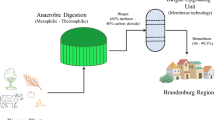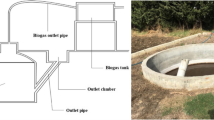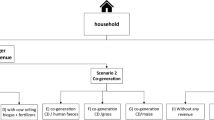Abstract
The development of biogas programs in rural China has led to great economic, social, ecological and environmental benefits. The focus of this study was the identification of the benefit relationship for various stakeholders via the evaluation of relevant policies, an analysis of the costs and benefits and an estimation of the environmental benefits of the livestock manure utilization in a biogas power generation company (BPGC) in Zhejiang province. The results demonstrated that the net present value (NPV) of the project was 8.85 million dollar, and the internal rate of return (IRR) was 36%. Compared to current projects, the BPGC had a higher investment potentiality. The annual environmental benefits of chemical oxygen demand and NH3–N reduction are 2.61 million dollar and 0.21 million dollar, respectively. The environmental benefits of the reduction of greenhouse gas emission is 1.54 million dollar/a. When the environmental benefits were considered in the cost–benefit analysis, the NPV of the project was 42.01 million dollar, and the IRR was 123.98%, and the BPGC exhibited significant social benefits. The government took advantage of a public–private partnership model to reach a common balance of benefits among government, enterprise, hog farms and the residents.


Similar content being viewed by others
References
National Bureau of Statistics (NBS) (2014) China statistical yearbook. China Statistics Press, Beijing (in Chinese)
Livestock Yearbook Editing Committee (LYEC) (2000) China livestock yearbook. China Agricultural Press, Beijing (in Chinese)
Livestock Yearbook Editing Committee (LYEC) (2011) China livestock yearbook. China Agricultural Press, Beijing (in Chinese)
Ministry of Agriculture (CMA) (1999) Chinese organic fertilizer resources. China Agriculture Press, Beijing (in Chinese)
The Chinese environmental bulletin (2004). State Environmental Protection Administration (SEPA), Beijing (in Chinese)
Ongley ED, Zhang X, Yu T (2010) Current status of agricultural and rural non-point source pollution assessment in china. Environ Pollut 158(5):1159–1168. doi:10.1016/j.envpol.2009.10.047
The first national pollution census bulletin (2010). National Bureau of Statistics (NBS), Beijing (in Chinese)
Liu B, Liu H, Zhang B, Bi J (2013) Modeling nutrient release in the tai lake basin of china: source identification and policy implications. Environ Manage 51(3):724–737. doi:10.1007/s00267-012-9999-y
Demirel B, Göl NP, Onay TT (2013) Erratum to: evaluation of heavy metal content in digestate from batch anaerobic co-digestion of sunflower hulls and poultry manure. J Mater Cycles Waste Manage 15(3):409–409. doi:10.1007/s10163-013-0142-9
Zhang H, Luo Y, Wu L, Huang Y, Christie P (2015) Residues and potential ecological risks of veterinary antibiotics in manures and composts associated with protected vegetable farming. Environ Sci Pollut Res 22(8):5908–5918. doi:10.1007/s11356-014-3731-9
Sungur A, Soylak M, Yilmaz S, Ozcan H (2016) Heavy metal mobility and potential availability in animal manure: using a sequential extraction procedure. J Mater Cycles Waste Manage 18(3):563–572. doi:10.1007/s10163-015-0352-4
Li F, Cheng S, Yu H, Yang D (2016) Waste from livestock and poultry breeding and its potential assessment of biogas energy in rural China. J Clean Product 126:451–460. doi:10.1016/j.jclepro.2016.02.104
Galka A (2004) Using a cleaner production preventive strategy for the reduction of the negative environmental impacts of agricultural production—using cattle husbandry as a case study. J Clean Product 12(5):513–516. doi:10.1016/S0959-6526(03)00108-2
Choi YS, Sang KC, Kim SJ, Han SY, Du SJ, Yoon TH et al (2017) Development of combined plant of biogas and bio solid-refuse-fuel from swine manure slurry. J Mater Cycles Waste Manage. doi:10.1007/s10163-017-0594-4
Fujino J, Morita A, Matsuoka Y, Sawayama S (2005) Vision for utilization of livestock residue as bioenergy resource in Japan. Biomass Bioenerg 29(5):367–374. doi:10.1016/j.biombioe.2004.06.017
Skoulou V, Zabaniotou A (2007) Investigation of agricultural and animal wastes in Greece and their allocation to potential application for energy production. Renew Sustain Energy Rev 11(8):1698–1719. doi:10.1016/j.rser.2005.12.011
Tsai WT, Lin CI (2009) Overview analysis of bioenergy from livestock manure management in Taiwan. Renew Sustain Energy Rev 13(9):2682–2688. doi:10.1016/j.rser.2009.06.018
Bidart C, Fröhling M, Schultmann F (2014) Livestock manure and crop residue for energy generation: macro-assessment at a national scale. Renew Sustain Energy Rev 38(5):537–550. doi:10.1016/j.rser.2014.06.005
Nhu TT, Dewulf J, Serruys P, Huysveld S, Nguyen CV, Sorgeloos P, Schaubroecka T (2015) Resource usage of integrated pig-biogas-fish system: partitioning and substitution within attributional life cycle assessment. Resour Conserv Recycl 102:27–38. doi:10.1016/j.resconrec.2015.06.011
Wang XJ, Lu XG, Yang GH, Feng YZ, Ren GX, Han XH (2016) Development process and probable future transformations of rural biogas in China. Renew Sustain Energy Rev 55:703–712. doi:10.1016/j.rser.2015.09.097
Lee Y, Oa SW (2016) Resource-recovery processes from animal waste as best available technology. J Mater Cycles Waste Manage 18(2):201–207. doi:10.1007/s10163-015-0422-7
Petersen SO, Sommer SG, Béline F, Burton C, Dach J, Dourmad JY et al (2007) Recycling of livestock manure in a entire-farm perspective. Livest Sci 112(3):180–191. doi:10.1016/j.livsci.2007.09.001
Walla C, Schneeberger W (2008) The optimal size for biogas plants. Biomass Bioenerg 32(6):551–557. doi:10.1016/j.biombioe.2007.11.009
Gebrezgabher SA, Meuwissen MPM, Prins BAM, Lansink AGJMO (2010) Economic analysis of anaerobic digestion—a case of Green power biogas plant in The Netherlands. Njas Wagening J Life Sci 57(2):109–115. doi:10.1016/j.njas.2009.07.006
Smyth BM, Smyth H, Murphy JD (2010) Can grass biomethane be an economically viable biofuel for the farmer and the consumer? Biofuels Bioprod Biorefin 4(5):519–537. doi:10.1002/bbb.238
Lantz M (2012) The economic performance of combined heat and power from biogas produced from manure in Sweden—a comparison of different CHP technologies. Appl Energy 98(1):502–511. doi:10.1016/j.apenergy.2012.04.015
Zheng CH, Yi L, Bluemling B, Mol APJ, Chen JN (2014) Environmental potentials of policy instruments to mitigate nutrient emissions in Chinese livestock production. Sci Total Environ 502C:149–156. doi:10.1016/j.scitotenv.2014.09.004
Pan D, Zhou G, Zhang N, Zhang L (2016) Farmers’ preferences for livestock pollution control policy in china: a choice experiment method. J Clean Product 131:572–582. doi:10.1016/j.jclepro.2016.04.133
Chen Y, Wang SJ, Chungchou T, Zhang CJ (2016) Assessment of subsidies to minimize environmental pollution by Intensive Hog Feeding Operation (IHFO). J Clean Product 112:2529–2535. doi:10.1016/j.jclepro.2015.09.090
Brown BB, Yiridoe EK, Gordon R (2007) Impact of single versus multiple policy options on the economic feasibility of biogas energy production: swine and dairy operations in Nova Scotia. Energy Policy 35(9):4597–4610. doi:10.1016/j.enpol.2007.03.023
Freeman R (1984) Strategic management: a stakeholder approach. Cambridge University Press, Cambridge
Sun B, Zhang L, Yang L, Zhang F, Norse D, Zhu Z (2012) Agricultural non-point source pollution in china: causes and mitigation measures. J Hum Environ 41(4):370–379. doi:10.1007/s13280-012-0249-6
Sunstein CR (2004) Cost-Benefit analysis and the environment. Soc Sci Electron Publ 115(2):195–221. doi:10.1007/BF01888891
Sgroi F, Foderà M, Trapani AMD, Tudisca S, Testa R (2015) Cost-benefit analysis: a comparison between conventional and organic olive growing in the Mediterranean Area. Ecol Eng 82:542–546. doi:10.1016/j.ecoleng.2015.05.043
Xiong XO, Li YX, Li W, Lin CY, Han W, Yang M (2010) Copper content in animal manures and potential risk of soil copper pollution with animal manure use in agriculture. Resour Conserv Recycl 54(11):985–990. doi:10.1016/j.resconrec.2010.02.005
Wu X, Wu F, Tong X, Wu J, Sun L, Peng X (2015) Emergy and greenhouse gas assessment of a sustainable, integrated agricultural model (SIAM) for plant, animal and biogas production: analysis of the ecological recycle of wastes. Resour Conserv Recycl 96:40–50. doi:10.1016/j.resconrec.2015.01.010
State Environmental Protection Administration (SEPA) (2002) The pollution investigation and prevention countermeasures of Chinese scale livestock and poultry breeding. China Environmental Science Press, Beijing
Yan TZ, Du HY, Xia W, Cheng B, Zheng F (2009) Poultry and animal feces pollution situation and countermeasures in Anhui province (in Chinese). Agro-Environ Dev 26(2):58–62. doi:10.3969/j.issn.1005-4944.2009.02.018
Zhang XM, Dong YH, Wang H, Shen D (2007) Pollution of livestock and poultry feces in jiangsu and countermeasures (in Chinese). Soils 39(5):708–712. doi:10.13758/j.cnki.tr.2007.05.020
ACM0010 (2006) Consolidated baseline methodology for GHG emission reductions from manure management systems [EB/OL]. http://cdm.unfccc.int/methodologies/index.html
IPCC (2006) IPCC guidelines for national greenhouse gas inventories Agriculture, forestry and other land use, vol 4. IGES, Japan
State Environmental Protection Administration (SEPA) (2004) The pollution coefficient table of livestock and poultry breeding. http://www.mep.gov.cn/gkml/zj/wj/200910/t20091022_172271.htm. Accessed 6 Mar 2016
National Development and Reform Commission (NDRC) (2009) Chinese regional power grid baseline emission factor. http://qhs.ndrc.gov.cn/qjfzjz/200907/t20090703_289357.html. Accessed 2 Mar 2016
Wang Z, Xiao ZY, Dai Y (2009) CDM project of large-scaled animal farms in arid region and estimation of greenhouse gas mitigation (in Chinese). J Ecol Rural Environ 25(4):1–7. doi:10.3969/j.issn.1673-4831.2009.04.001
Ma RH, Ding YF, Nan GL, Ma ZH (2008) Economic evaluation of scale pig farm methane project based on the clean development mechanism (in Chinese). Chin J Anim Sci 44(17):50–52
Hong YZ, Lin B, Dai YW, Yu JH (2010) Economic benefits evaluation of large-scale pig farm biogas project based on sensitivity analysis (in Chinese). Chin Agric Sci Bull 26(14):388–391
Wang XL, Chen YQ, Peng S, Gao WS, Feng Q, Xia W (2014) Efficiency and sustainability analysis of biogas and electricity production from a large-scale biogas project in China: an emergy evaluation based on LCA. J Clean Product 65(4):234–245. doi:10.1016/j.jclepro.2013.09.001
Chen Y, Hu W, Feng Y, Sweeney S (2014) Status and prospects of rural biogas development in China. Renew Sustain Energy Rev 39(6):679–685. doi:10.1016/j.rser.2014.07.119
Rasheed R, Khan N, Yasar A, Su YH, Tabinda AB (2016) Design and cost-benefit analysis of a novel anaerobic industrial bioenergy plant in Pakistan. Renew Energy 90:242–247. doi:10.1016/j.renene.2016.01.008
He Z, Peng J (2015) Evaluation on the external environment cost of pig-breeding with different size in sichuan province of China. Environ Prog Sustain Energy 34(5):1488–1496. doi:10.1002/ep.12139
Sorda G, Sunak Y, Madlener R (2013) An agent-based spatial simulation to evaluate the promotion of electricity from agricultural biogas plants in Germany. Ecol Econ 89(3):43–60. doi:10.1016/j.ecolecon.2013.01.022
Rupf GV, Bahri PA, Boer KD, Mchenry MP (2015) Barriers and opportunities of biogas dissemination in Sub-Saharan Africa and lessons learned from Rwanda, Tanzania, China, India, and Nepal. Renew Sustain Energy Rev 52:468–476. doi:10.1016/j.rser.2015.07.107
Wang HL, Fan M, Luo CL, Xi XP, Shi JM, Sun LY (2014) Case study on carbon dioxide reduction of biogas power generation in large-scale pig farm (in Chinese). Jiangxi Sci 32(5):674–678. doi:10.13990/j.issn1001-3679.2014.05.021
Stürmer B, Schmid E, Eder MW (2011) Impacts of biogas plant performance factors on total substrate costs. Biomass Bioenerg 35(4):1552–1560. doi:10.1016/j.biombioe.2010.12.030
Wang XL, Li ZJ, Long P, Yan LL, Gao WS, Chen YQ, Sui P (2016) Sustainability evaluation of recycling in agricultural systems by emergy accounting. Resour Conserv Recycl 117:114–124. doi:10.1016/j.resconrec.2016.11.009
León E, Martín M (2016) Optimal production of power in a combined cycle from manure based biogas. Energy Convers Manage 114:89–99. doi:10.1016/j.enconman.2016.02.002
Acknowledgements
This paper is supported by Renmin University of China: the special developing and guiding fund for building world-class universities (disciplines).
Author information
Authors and Affiliations
Corresponding author
Rights and permissions
About this article
Cite this article
Xu, X., Ma, Z., Chen, Y. et al. Circular economy pattern of livestock manure management in Longyou, China. J Mater Cycles Waste Manag 20, 1050–1062 (2018). https://doi.org/10.1007/s10163-017-0667-4
Received:
Accepted:
Published:
Issue Date:
DOI: https://doi.org/10.1007/s10163-017-0667-4




